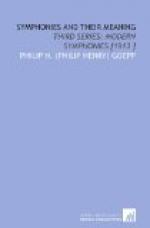Right in the answer is a guise of short, nervous phrase, that gets a new touch of bizarre by a leap of the seventh from below. In this figure that moves throughout the symphony we see an outward symbol of an inner connection.—Bells soon lend a festive ring to the main tune.
In quieter pace comes a tranquil song of lower voices with a companion melody above,—all in serene major. Though it grew naturally out of the rude
[Music: Molto cantabile]
dance, the tune has a contrasting charm of idyll and, too, harks back to the former lyric strains that followed the second melody. When the dance returns, there is instead of discussion a mere extension of main motive in full chorus.
But here in the midst the balance is more than restored. From the dance that ceases abruptly we go straight to school or rather cloister. On our recurring nervous phrase a fugue is rung with all pomp and ceremony (meno mosso); and of the dance there are mere faint echoing memories, when the
[Music: Meno mosso (Oboe) molto marcato (Violins) staccato]
fugal text seems for a moment to weave itself into the first tune.
Instead, comes into the midst of sermon a hymnal chant, blown gently by the brass, while other stray
[Music: Leggiero]
voices run lightly on the thread of fugue. There is, indeed, a playful suggestion of the dance somehow in the air. A final tempest of the fugue[A] brings us back to the full verse of dance and the following melodies. But before the end sounds a broad hymnal line in the brass with a dim thread of the fugue, and the figures steal away in solemn stillness.
[Footnote A: It is of the first two notes of the symphony that the fugal theme is made. For though it is longer in the strings, the brief motion is ever accented in the wood. Thus relentless is the themal coherence. If we care to look closer we see how the (following) chant is a slower form of the fugal theme, while the bass is in the line of the dance-tune. In the chant in turn we cannot escape a reminder, if not a likeness, of the second theme of the first movement.]
III.—The Adagio has one principal burden, first borne by violins,—that rises from the germ of earlier
[Music: Adagio (Strings with added harmony in bassoons and horns)]
lyric strains. Then the clarinet joins in a quiet madrigal of tender phrases. We are tempted to find here an influence from a western fashion, a taint of polythemal virtuosity, in this mystic maze of many strains harking from all corners of the work, without a gain over an earlier Russian simplicity. Even the Slavic symphony seems to have fallen into a state of artificial cunning, where all manners of greater
[Music: (Solo clarinet) espress. (Divided strings) dolce]
or lesser motives are packed close in a tangled mass.




